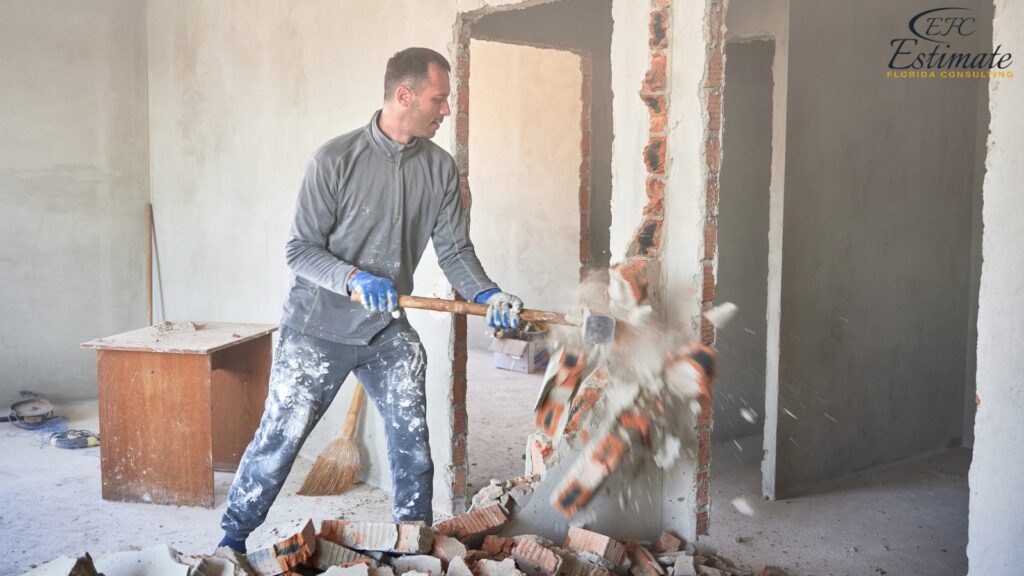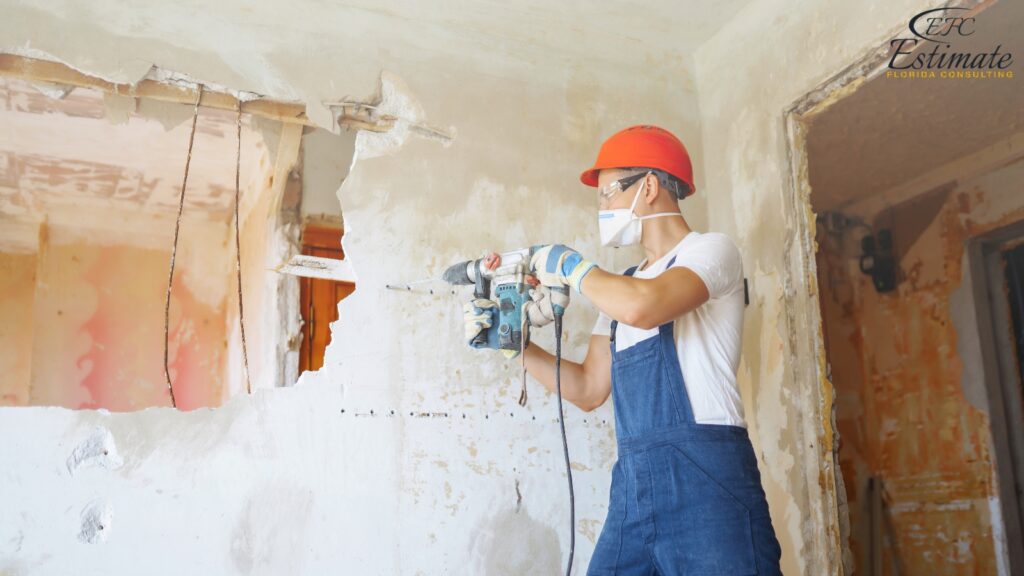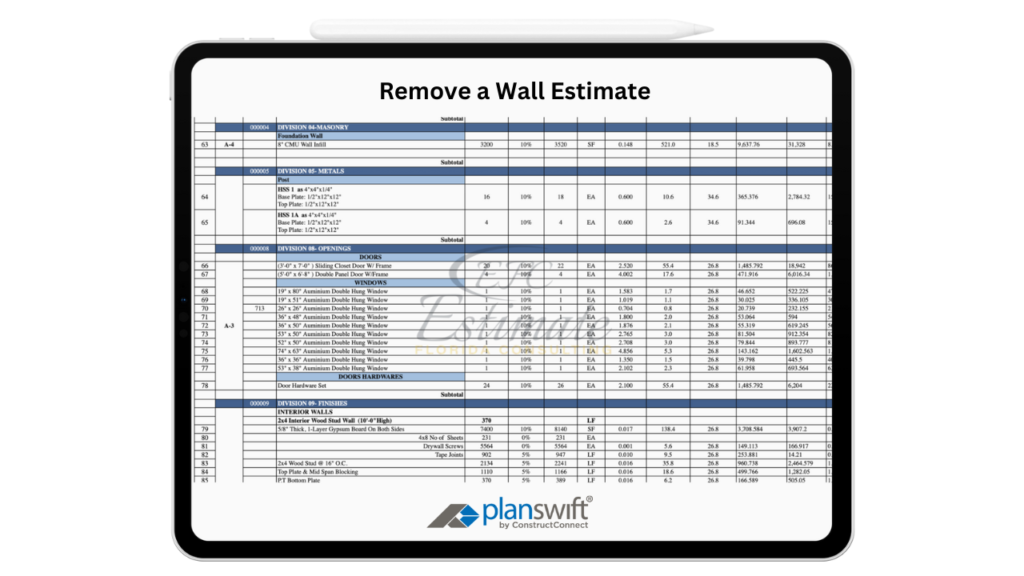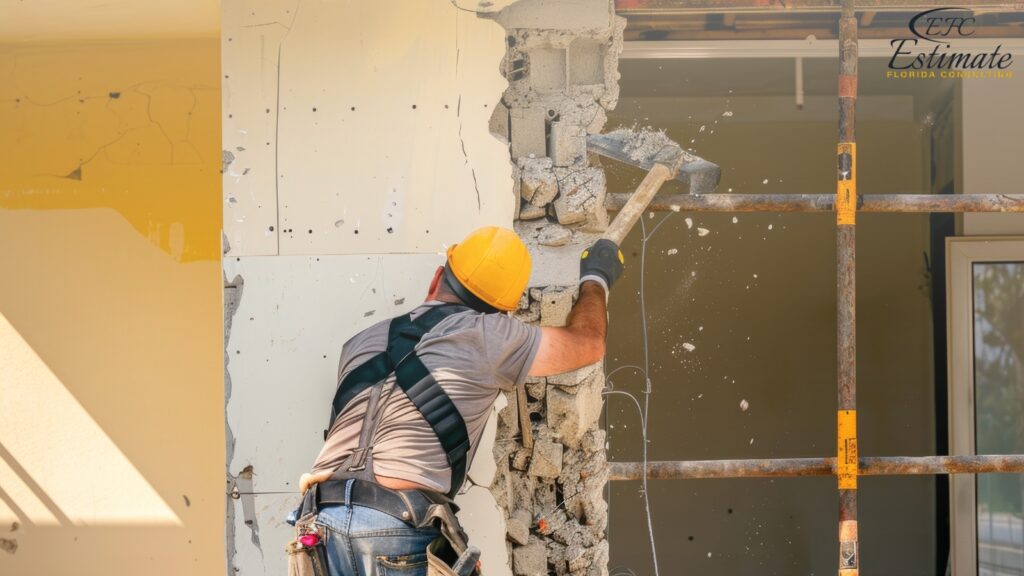How Much Does It Cost To Remove a Wall?
The average cost to remove a non-load-bearing wall is typically between $650 and $2,600. If you’re looking to remove a load-bearing wall, the cost rises significantly, ranging from $5,200 to $13,000 for a single-story home and $11,700 to $19,500 for a multi-story house. These costs can vary depending on the size of the wall, the need to reroute utility lines, and whether additional structural support is required.
If you need to hire a structural engineer for calculations related to load-bearing wall removal, expect to pay between $390 and $1,300.

Additionally, creating a kitchen pass-through can cost anywhere from $1,300 to $5,200, depending on the size and complexity of the project.
Cost To Remove a Wall | Non Load-Bearing | Load-Bearing |
Empty Wall | $650 – $1,950 | $2,600 – $6,500 |
Wall + Rerouting Utilities | $1,950 – $4,550 | $5,200 – $13,000 |
Two-Story Wall / Complex Job | $5,200+ | $11,700 – $19,500 |
Kitchen Pass-Through | $650 – $1,950 | $1,300 – $6,500 |
Always consult with a structural engineer to ensure that removing a wall won’t cause any structural damage to your home. This step is crucial for maintaining the integrity and safety of your property.
Additionally, it’s essential to hire a licensed contractor rather than a handyman for this type of work. A licensed contractor will ensure that the necessary permits are obtained and that the job is done to the highest standards, following all relevant building codes and regulations.
Cost to Remove a Load-Bearing Wall
Removing a load-bearing wall in a single-story home typically costs between $5,200 and $13,000, including finishing work. For a two-story home, the cost to remove a load-bearing wall averages between $11,700 and $19,500. Before providing an accurate estimate, a load-bearing wall removal contractor will need to inspect your home to assess the structural requirements.
Cost To Remove A Load-Bearing Wall | Average Cost |
Single-Story Wall | $5,200 – $13,000 |
Two-Story Wall | $11,700 – $19,500 |
The cost to remove a load-bearing wall varies based on several factors. These include the width of the opening, whether there are additional walls below or above the floor, and whether additional concrete footings or piers are required for support. Costs also increase if you need to open up the ceiling to double or triple the joists to carry the new load.
Expenses can rise further if rerouting utility lines is necessary, if a basement wall that bears more weight needs to be removed, or if the connecting rooms require refinishing to match the new construction.
Cost to Replace a Load-Bearing Wall with a Beam
Installing a steel beam to replace a load-bearing wall typically costs between $1,300 and $5,200, depending on the size of the wall, the type of beam used, labor, and the architecture of the house. In some cases, columns or posts may be required to support the new structure, depending on the home’s design.
A structural engineer must design and size the new beam to prevent issues such as sagging ceilings, uneven floors, or even roof collapse. Additional costs will apply for permits, inspections, demolition of the old wall, and finishing work.
Get Acquainted with Wall Removing
Cost of a Load-Bearing Support Beam
A load-bearing support beam typically costs between $3.90 and $45.50 per linear foot, with most homeowners spending around $13 to $19.50 per linear foot. For a laminated veneer lumber (LVL) beam, the cost averages between $78 and $390, not including installation.
Load-Bearing Support Beam Cost | Cost Per Linear Foot |
Steel Beam | $7.80 – $31.20 |
Wood Beam (Hardwood & Softwood) | $6.50 – $45.50 |
Glulam Beam (Engineered Lumber) | $7.80 – $28.60 |
LVL Beam (Engineered Lumber) | $3.90 – $15.60 |
Poured Concrete Beams | $9.10 – $19.50 |
Cost to Create a Kitchen Pass-Through or Half-Wall
The average cost to create a kitchen pass-through or half-wall ranges from $1,950 to $4,550 in total, or $91 to $195 per square foot. The total cost depends on the number of utility lines inside the wall, whether the wall is load-bearing, and the size of the new opening.
Cost to Create a Kitchen Pass-Through or Half-Wall
Project | Average Cost |
Non-Load-Bearing | $650 – $1,950 |
Load-Bearing w/ Beam | $1,300 – $6,500 |
Large Load-Bearing w/ Beam | $13,000+ |
Framing a pass-through wall with casing, molding, or paneling trim typically costs $130 to $260 per opening. Some homeowners opt to install a kitchen island instead to add more counter space.
Cost of Replacing Support Beams in a Basement
Replacing a support beam in your basement typically costs between $8,450 and $13,000, depending on the length and material of the beam. If you need to replace a long support beam and remove more than one load-bearing wall in the basement, the costs can exceed $26,000.
Support beams usually need to be replaced if the wooden braces become infested with termites, start to rot due to water damage, or have simply deteriorated with age.

Cost to Knock Down a Non-Load-Bearing Wall
The average cost to remove an internal non-load-bearing wall ranges from $1,040 to $1,950, which includes demolition, debris removal, patching, hanging drywall, painting, and more. If electrical and plumbing need to be rerouted, the cost typically increases to between $1,950 and $4,550.
Type | Average Cost |
Demolition Only | $130 – $390 |
Full Removal (Demo, Debris Removal, New Drywall) | $1,040 – $1,950 |
Full Removal w/ Electrical & Plumbing Rerouting | $1,950 – $4,550 |
In most projects, utility lines running through the wall must be rerouted, which adds to the cost. Prices also depend on the size of the wall, the wall material, and the number and type of utility lines involved.
Additionally, permits or inspection fees may increase the overall cost. Extra expenses might apply for texturing, painting, refinishing, baseboards, and flooring.
Cost to Demolish a Wall by Material
The average cost to demolish a wall ranges from $130 to $390 or between $0.65 and $1.95 per square foot, depending on whether it’s made of wooden studs, brick, or concrete. If contractors need to open up additional walls to reroute utilities, the extra drywall removal will cost between $52 and $260 per wall.
Material | Cost Per Square Foot | Average Wall Cost |
Drywall | $0.39 – $0.59 | $39 – $85 |
Plaster | $0.59 – $0.98 | $59 – $143 |
Stud Wall | $0.85 – $1.69 | $78 – $241 |
Concrete | $2.86 – $6.11 | $273 – $884 |
Brick | $3.77 – $8.32 | $364 – $1,196 |
90% More Chances to Win Projects With Our Estimate!
- Multi-Family Building
- Hotel Building
- Hospital Building
- Warehouse Building
- School & University Building
- High-Rise Building
- Shopping Complex
- Data Center Building

Cost to Remove an Interior vs. Exterior Wall
While a structural engineer can remove almost any interior wall, removing an exterior wall is a much more complex and costly process. Since all exterior walls are load-bearing, removing them poses significant risks to the structural integrity of your home and is rarely done.
Removing an exterior wall is more expensive because it requires installing large columns, beams, and additional supports to maintain the structure’s stability. Even in home additions, external structural walls are typically left intact, with modifications made only to add doorways or other access points. The complexity and potential risks associated with exterior wall removal make it a much costlier endeavor.
Cost Factors to Tear Down a Wall
The cost of tearing down a wall can vary depending on several factors, including the need to reroute plumbing and electrical lines, replace drywall, repaint, and more. It’s also important to be prepared for unexpected surprises inside the walls, which can add up to 20% to your total cost.
Item | Average Cost |
Remove Drywall | $260 – $650 |
Install Temporary Supports | $780 – $1,300 |
Remove Bearing Wall | $520 – $780 |
Cut Framing & Install New Beam | $1,300 – $2,600 |
Install New Drywall & Finish | $1,040 – $1,820 |
Cut Floor & Install Concrete Footings (Optional) | $1,950 – $3,250 |
Total Cost to Open Up a Wall in Your Home
The total cost to open up a wall in your home can vary significantly depending on several key factors:
- Is your wall load-bearing?
- Are there electrical outlets, switches, wiring, heating and cooling ducts, or plumbing in the wall that need to be moved or relocated?
- What kind of material is your wall made of?
- Are your ceiling beams and foundation currently in good condition, or will they need extra support?
- How will you refinish your floors, walls, and ceiling surfaces after removing the wall?
Load-Bearing Wall Removal Calculations
When planning to remove a load-bearing wall, it’s essential to hire a structural engineer to determine the type and size of beam needed and the load it must support. The structural engineer will conduct a thorough analysis of your home’s weight-bearing structure and ensure that the foundation’s footings can handle the extra weight once the wall is removed.
Removing a load-bearing wall shifts the weight to other areas of the foundation, which can cause severe structural damage if not properly managed. An inspection is necessary before you can apply for permits or a federal home renovation loan.
For homes with a pier and beam foundation instead of a concrete slab, with roofing materials other than composite shingles, or with ceilings higher than 10 feet, expect to pay an additional $1,300 or more to remove the wall.
Cost of Structural Engineer for Load-Bearing Wall
Hiring a structural engineer for a load-bearing wall analysis typically costs between $390 and $1,300, depending on the project’s complexity. Structural engineers can custom-design new beams, recommend specific beam sizes, and prepare detailed drawings for contractors to make structural changes.
Permits & Building Regulations
Building permits, which start at $100 or more, are required for any project involving the removal of load-bearing walls. The architect’s fee for a structural engineering schematic typically costs $650 and up, depending on the scope of the project.
Licensed contractors will create construction plans and handle the permit application process to ensure compliance with building regulations. Most states require a structural engineer and building inspector to evaluate the structure and check for asbestos before permits are issued.

Single vs. Two-Story Wall Removal
Removing a load-bearing wall in a two-story home is more expensive because it requires larger and stronger beams to support the additional weight of the second floor and roof. In some cases, removing complex two-story load-bearing walls can cost between $26,000 and $39,000.
Cost to Hide a Load-Bearing Beam
The cost to install and recess a steel beam typically ranges from $221 to $585 per linear foot, or between $2,600 and $10,400, depending on the need for additional support. Steel beams are the preferred choice since they take up less space. However, recessing a beam might not be possible without damaging the floor in the upper room, and if the beam is too close to the slope of the roof, it could affect the roof’s structure.
More affordable options include wrapping the beam in special trim or paneling or painting it the same color as the ceiling to help it blend in.
Plumbing
Plumber hourly rates typically range from $59 to $195, with a standard service call-out fee starting at $98 or more. The total cost will depend on the type, age, and number of pipes that need to be removed, rerouted, or replaced within the wall.
Structural engineers can collaborate with plumbers to determine the most cost-effective rerouting designs and help locate main water lines to avoid accidental damage during demolition.
Electrical
Electrician hourly rates generally range from $65 to $169, depending on their experience and the job’s complexity. Even if there are no visible outlets or switches in the wall being removed, rewiring light switches, outlets, fixtures, and junction boxes may be necessary. Additional costs may arise if the wiring inside the walls is outdated or damaged.
Opening walls in older homes often reveals outdated electrical wiring that must be brought up to current code, further increasing the project costs.
New Drywall Installation
After removing a wall, new drywall installation typically costs between $1.95 and $4.55 per square foot to patch the exposed areas. The final price depends on the size of the job, the type of drywall used, and any structural complexities like correcting uneven surfaces or creating half-walls.
Painting
Professional painters charge between $26 and $65 per hour or roughly $2.60 to $7.80 per square foot for interior painting. If your walls require crack repairs, sanding, or painting of trim, ceilings, and other features, expect additional costs.
Wallpaper Removal & Installation
Removing wallpaper from adjacent walls costs between $1.30 and $2.60 per square foot, depending on whether it has been painted over or if the glue is difficult to remove. To match the adjoining walls, wallpaper installation typically costs between $3.90 and $9.10 per square foot, covering both labor and materials. While it might be tempting to remove wallpaper yourself, doing it incorrectly can strip off the outer layers of drywall, leading to more costly repairs.
Re-Adding Texture to Walls
The average cost to texture walls ranges from $1.04 to $2.60 per square foot for supplies and labor. Prices can vary based on the size of the space, the complexity of the job, and the amount of prep work needed. Leveling the surrounding surface and applying primer before texturing will incur additional costs.
Installing New Cabinets and Countertops
Creating a kitchen pass-through between rooms may require installing new cabinets, which costs between $195 and $650 per linear foot. Installing countertops on a half-wall ranges from $32.50 to $130 per square foot, depending on the material and labor involved. If you need to move and reinstall basic wall cabinets to another location, contractors typically charge $19.50 to $26 per linear foot.
Flooring
Matching the floors in connecting rooms after removing a wall can be challenging and may require replacing the flooring. The average cost to replace flooring is between $5.20 and $19.50 per square foot, depending on the type of material chosen.
Additional Expenses
Removing a wall can lead to unexpected expenses, especially if your home is older or has underlying issues:
- Asbestos, Mold, and Mildew: Inspectors will check for mold and asbestos before construction begins to avoid health risks. Asbestos removal costs between $9.10 and $18.20+ per square foot, while mold removal ranges from $19.50 to $39 per square foot.
- Termite Damage: If termites or other pests are found inside your walls, the average cost of treatment is between $429 and $1,040, plus the expense of replacing any damaged wood framing and beams.
- Lead Paint: If lead paint is present, it must be disposed of and cleaned up carefully. DIY lead paint testing costs about $32.50, or you can hire an inspector for around $390.
- Debris Removal: Wall removal creates significant debris that needs to be disposed of properly. Dumpster rentals typically range from $364 to $650 per week, including delivery and pickup.
- Foundation Support: Redirecting the weight load from a wall to one or two posts may require additional foundation support. Contractors might need to add new posts in the basement or crawl space or strengthen the footings under the foundation to ensure stability.
Average Cost to Move a Wall in Your Home
Moving a wall in your home is generally not recommended due to the significant risks of structural damage. The process involves demolishing the existing wall and then paying to construct a new one. The average cost to frame and build a new wall ranges from $1,170 to $3,250, depending on the size of the wall and whether it’s load-bearing. This cost increase reflects the added complexity and potential challenges involved in such a project.
Download Template For Remove a Wall Project Breakdown
- Materials list updated to the zip code
- Fast delivery
- Data base of general contractors and sub-contractors
- Local estimators

Conclusion
The cost to remove a wall in your home can vary widely depending on several factors, including whether the wall is load-bearing, the need to reroute utilities, and the complexity of the project. Non-load-bearing walls are generally more affordable to remove, with costs ranging from $650 to $2,600, while removing a load-bearing wall can range from $5,200 to $19,500 or more. Additional expenses such as hiring a structural engineer, obtaining permits, and finishing work can further increase the overall cost. Always consult professionals to ensure the structural integrity and safety of your home.
FAQs
The cost to remove a non-load-bearing wall typically ranges between $650 and $2,600, depending on the wall’s size and whether any utility lines need to be rerouted.
Removing a load-bearing wall can cost between $5,200 and $13,000 for a single-story home, and between $11,700 and $19,500 for a multi-story house. The final cost depends on the structural complexity and additional support needed.
Hiring a structural engineer for load-bearing wall removal calculations typically costs between $390 and $1,300, depending on the project’s complexity.
Factors that affect the cost include the type of wall (load-bearing or non-load-bearing), wall size, the need to reroute utilities, structural support requirements, and whether the project involves additional finishing work like drywall, painting, or flooring.
The cost to create a kitchen pass-through or half-wall ranges from $1,300 to $5,200, depending on the wall’s size, whether it’s load-bearing, and the complexity of the project.
Installing a steel beam to replace a load-bearing wall typically costs between $1,300 and $5,200. Costs depend on the beam type, wall size, and the home’s architecture. Additional support, like columns or posts, may also be required.
Removing a load-bearing wall in a two-story home is more expensive, typically ranging between $11,700 and $19,500, due to the need for larger beams and additional structural support.
The cost to remove a non-load-bearing wall typically ranges from $1,040 to $1,950. If electrical and plumbing need to be rerouted, costs can increase to between $1,950 and $4,550.
Google Reviews



Process To Get Build A Room Cost Estimate Report
Here I am going to share some steps to get build a rom cost estimate report.
-
You need to send your plan to us.
You can send us your plan on info@estimatorflorida.com
-
You receive a quote for your project.
Before starting your project, we send you a quote for your service. That quote will have detailed information about your project. Here you will get information about the size, difficulty, complexity and bid date when determining pricing.
-
Get Estimate Report
Our team will takeoff and estimate your project. When we deliver you’ll receive a PDF and an Excel file of your estimate. We can also offer construction lead generation services for the jobs you’d like to pursue further.

